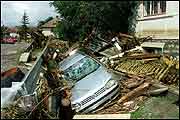Transylvanian Unitarians rebuild, look to future
Donations from UUA, Partner Church Council help restore villages ravaged in last year's floods.
Strong and well-established relationships helped bring speedy aid to flood-stricken Unitarian villages in Transylvania after the flood last August, according to Cathy Cordes, director of the Unitarian Universalist Partner Church Council and [now part-time] interim director of the Unitarian Universalist Association of Congregations’ International Office. These relationships, in the form of partnerships between North American Unitarian Universalist congregations and Transylvanian Unitarian churches, facilitated the transfer of the more than $300,000 for flood relief from North American Unitarian Universalists—raised through the auspices of the Council—to their Transylvanian co-religionists.
Working with the Nyikó Valley Flood Relief and Rehabilitation Committee, which was formed immediately by the Transylvanians to process donations and prioritize needs, the Council was able to provide money for emergency relief in the form of vouchers issued to individuals for rebuilding, the purchase of construction materials, cash allotments for immediate necessities, and the organization of relief efforts, according to a January 2006 Council report. After the most pressing needs were met, the money was used for an additional round of vouchers to affected families, the renovation of Kobátfalva’s center—which was almost completely destroyed by the flood—the implementation of flood control measures, and the reconstruction of roads.
The mountainous Transylvanian section in northwest Romania has been home to Unitarian congregations since Francis Davíd preached there in 1566. By the time of his death in 1579 there were 500 Unitarian churches there—one of his converts was King John Sigismund, who proclaimed a policy of religious tolerance in 1568. Unitarianism is still a dynamic force in this area, with churches playing a leading role in village life. The structure of the church there is more hierarchical than in the United States, with a Unitarian bishop presiding over the entire Transylvanian Unitarian church.
Transylvanians are ethnically Hungarian, and a minority in Romania who have suffered persecution over the years from the combined forces of fascism, Nazism, and Communism. Transylvanian Unitarians formed their first ties with North American Unitarian churches in the 1920s, according to Cordes. These ties were severed during the Communist regime and were reestablished in 1990 with the help of the UUA. The Council was formed as an independent organization in 1993 to support the partnerships.
The day after the flood, Cordes contacted UUA President William G. Sinkford. “I told him that if we don’t help the Unitarians, then who will?” she recalled. Sinkford responded immediately, she said, by combining forces with the Council to set up a relief fund. Within 24 hours, calls for donations for the Transylvanian Unitarians were posted on both the Council’s website at uupcc.org and the UUA’s website at uua.org.
With the occurrence of Hurricane Katrina on August 29, it looked like relief to Romania might be overshadowed by the more visible needs of the Gulf Coast. However, congregations, especially those with relationships to Transylvanian churches, continued to respond generously. Cordes said that the Rev. James Ford, minister of First Unitarian Society in Newton, Mass., sent a letter to his congregants, which Cordes posted on the Council’s website, writing: “I believe we all have a sense of the horror on the Gulf Coast. I think it’s important to not lose sight of the tragedy in Transylvania, as well. I’m sure the world isn’t noticing, and their need is great.” In response, Ford proposed that the entire collection from the September 11, 2005, service at his church be split, with 75 percent going to the Gulf Coast Relief Fund and 25 percent to Transylvanian relief.
“I know that other churches picked up on his model,” Cordes said.
In addition to funds raised by the UUA-UUPCC fund, the UU Congregation at Shelter Rock, in Manhasset, N.Y., made a $100,000 donation, and the Council itself contributed $20,000. Donations have also been received from other churches and groups both in Romania and abroad.
Besides raising money for flood relief, the Council also has a continuing program of organizing work trips to the area. Much of the post-flood reconstruction labor has been donated by both Transylvanian and international volunteers.
Again, relationships have played an important role in motivating volunteers to make the trip. Anne Mark, a member of the Unitarian Universalist Church of Reading, Mass., which has a partner church in Jára, accompanied two teens from her church on a two-week Council-sponsored work pilgrimage in July. “If there’s one thing I’ve learned in 28 years of adult church-going,” Marks said, “it’s that people get to know each other best when they’re working next to each other, so the idea of work parties involving U.S. UUs and people from the flooded villages really appealed to me.”
The work wasn’t easy; Mark’s work party was part of a rock-hauling crew in the construction of a new dam. “Each little group went off with a tractor-driver and his cart,” she explained. “We threw rocks from other little stream-beds into the carts—some people used pickaxes to dislodge big rocks, others made bucket-brigade lines to pass the rocks into the carts.”
Communicating with their fellow workers was difficult in the beginning, Marks said, with the Americans sitting under one tree to eat lunch and the Kobátfalvans under another. But toward the end of the week things changed: “Friday after lunch the women from Kobátfalva brought pictures from home of their sons and daughters and grandchildren; we stood by the little wall around the Unitarian church and saw their families. . . . By working together, we had gone from sitting under separate trees to the beginning of an exchange and an acquaintance.”
The Council has around 150 partnerships between North American congregations and Unitarian congregations abroad. More than 120 of these partnerships are with churches in Transylvania. Additional partnerships have now been formed with congregations in Hungary, India, Poland, the Czech Republic, and the Philippines.
See sidebar for links to related resources.








